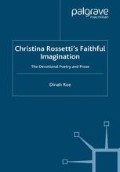Abstract
William Michael Rossetti writes of his younger sister, ‘In poetry she was (need I say it?) capable of appreciating what is really good; and yet her affections, if not her perceptions, in poetry, were severely restricted’ (Memoir lxix). For Christina Rossetti, the effect of ‘what is really good’ in Romantic poetry was allowed to germinate before the Pre-Raphaelite influence, and, arguably, before the Tractarian influence. Although Rossetti’s religious feeling restricted her affections for certain poems, William Michael notes that her ‘perceptions’, that is, her critical faculties, remained intact. In other words, Rossetti was, despite her religious restrictions, capable of critically separating, to an extent, the issue of morality from artistic merit, as her response to the Romantics illustrates. The young Rossetti’s discovery of Romantic poetry runs alongside her developing Anglo-Catholicism, while her writerly experiments take place within the nascent Pre-Raphaelite movement. Her work of this period struggles to extract a Tractarian ‘subtle virtue’ from a Romantic and Pre-Raphaelite ‘cup of curious dyes’. Rossetti effects this alchemy by reading the Romantics through the Tractarians, whose poetry reworked the Romantic sense of nature’s relationship to the human imagination to imbue it with transcendent, explicitly Christian meaning.1 What Rossetti learned from the Romantics concerns the power of the imagination, its relationship to the self, and a sense of the vital and organic importance of poetry.
Access this chapter
Tax calculation will be finalised at checkout
Purchases are for personal use only
Preview
Unable to display preview. Download preview PDF.
Notes
Mackenzie Bell, Christina Rossetti: A Biographical and Critical Study (London: Hurst and Blackett Limited, 1898), p. 13.
For a discussion of the Pre-Raphaelite Brotherhood’s role in the artistic and commercial rehabilitation of Keats in nineteenth-century art, see Sarah Wooton’s essay, ‘Ghastly Visualities: Keats and Victorian Art,’ in The Influence and Anxiety of the British Romantics, ed. Sharon Ruston (Lewiston: Edwin Mellen Press, 1999), pp. 159–80.
George H. Ford, Keats and the Victorians: A Study of his Influence and Rise to Fame, 1821–1895. (London: Archdon Books, 1962), p. 107–8. Christina Rossetti is only mentioned once in this book.
It was a view shared by Oscar Wilde who wrote of Keats as the ‘the forerunner of the Pre-Raphaelite school’. Quotation taken from Susan J. Wolfson, ‘Feminizing Keats’, Critical Essays on John Keats, ed. Hermione De Almeida (Mass: W. W. Norton and Co., 1990), p. 336.
J. B. Bullen, The Pre-Raphaelite Body: Fear and Desire in Painting, Poetry, and Criticism (Oxford: Clarendon Press, 1998), p. 7.
Ruskin’s pamphlet, Pre-Raphaelitism, is in The Complete Works of John Ruskin, ed. E. T. Cook and Alexander Wedderburn, vol. 13 (London: George Allen, 1904), p. 358.
James W. Hood, introduction to Divining Desire: Tennyson and the Poetics of Transcendence (Aldershot: Ashgate, 2000), p. 8.
Barbara Fass, ‘Christina Rossetti and St. Agnes’ Eve’, Victorian Poetry (spring, 1976) 33.
Thomas Parnell, ‘The Hermit’, Collected Poems of Thomas Parnell, ed. Claude Rawson and F. P. Lock (Delaware: University of Delaware Press, 1989), l. 23.
Hönnighausen, Gisela, ‘Emblematic Tendencies in the Works of Christina Rossetti’, Victorian Poetry 10 (1972) 4.
Antony H. Harrison, Christina Rossetti In Context (Brighton: The Harvester Press, 1988), p. 9.
Susan J. Wolfson, “Keats and Gender Criticism,” The Persistence of Poetry: Bicentennial Essays on Keats. eds. Robert M. Ryan and Ronald A. Sharp (Amherst: University of Massachusetts Press, 1998), p. 89.
Susan J. Wolfson, “Keats Enters History: Autopsy, Adonais, and the Fame of Keats”, Keats and History, ed. Nicholas Roe (Cambridge: Cambridge University Press, 1995), p. 31.
P. B. Shelley, Preface to ‘Adonais’, Shelley’s Poetry and Prose, ed. Donald R. Heiman and Sharon B. Powers (New York: W. W. Norton and Company, 1977), p. 391.
Copyright information
© 2007 Dinah Roe
About this chapter
Cite this chapter
Roe, D. (2007). ‘Decayed Branches from a Strong Stem’: Rossetti’s Keatsian Heritage. In: Christina Rossetti’s Faithful Imagination. Palgrave Macmillan, London. https://doi.org/10.1057/9780230625204_3
Download citation
DOI: https://doi.org/10.1057/9780230625204_3
Publisher Name: Palgrave Macmillan, London
Print ISBN: 978-1-349-28187-9
Online ISBN: 978-0-230-62520-4
eBook Packages: Palgrave Literature & Performing Arts CollectionLiterature, Cultural and Media Studies (R0)

